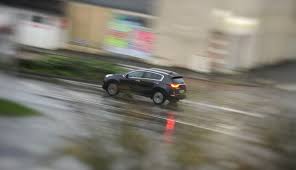
PUMPA - SMART LEARNING
எங்கள் ஆசிரியர்களுடன் 1-ஆன்-1 ஆலோசனை நேரத்தைப் பெறுங்கள். டாப்பர் ஆவதற்கு நாங்கள் பயிற்சி அளிப்போம்
Book Free DemoConsider a car stopped at the signal due to traffic. Now, once the signal changes to green, suddenly, the car's speed is increased to move faster, and this act of increasing the speed is called acceleration.

A fast moving car
Uniform velocity:
The velocity of an object moving uniformly in a straight line remains constant over time. The change in velocity of the object over any time interval will be zero.
Non-uniform velocity:
In non-uniform motion, velocity has different values at different instants and different points of the path. The change in velocity over any time interval will not be zero.
Acceleration:
A physical quantity called acceleration is the rate of change of velocity. In general, it is the increase in the velocity of an object with respect to time. The SI unit of acceleration is \(m s_{-2}\).
When an object's velocity is varying from the initial value \(u\) to the final value \(v\) in time \(t\), the acceleration \(a\) is given as,
This type of motion is called accelerated motion.
Types of acceleration:
- Positive acceleration
- Negative acceleration
Positive acceleration:
If the velocity of an object increases with respect to time, then the object is said to be in positive acceleration. For example, a van moving with increasing speed has a positive acceleration.
Negative acceleration:
If the velocity of an object acts opposite to the direction of motion, then the object is said to be in negative acceleration or deceleration or retardation. For example, a running car slowly stops possessing a negative acceleration.
Acceleration can be classified into uniform or non-uniform with respect to change in velocity and time.
Uniform Acceleration:
The uniform acceleration occurs when the velocity of an object changes (increases or decreases) for equal intervals of time in an equal amount while travelling in a straight line.
Example:
1. The motion of a freely falling body
2. Raindrops falling to the land

Falling raindrops
Non-uniform Acceleration:
An object undergoes non-uniform acceleration if the change in its velocity for every unit of time is not the same.
Example:
1. The motion of the car with changing speed
2. A car travelling in a circular path

Curvy road